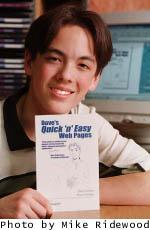



|
By a Kid, for a Kid! Dave Lindsay writes his first book about HTML
|
| First, a quick recap. During a family vacation in 1995, we visited a friend who convinced my dad that we were missing out by not being on the Net. As soon as we got home my dad got Internet access and bought an "Internet kit." It was just a box with a huge textbook, and a floppy disk with some shareware programs. While my dad was reading his two-inch-thick textbook cover to cover, I sat down at the computer and started typing. In perhaps 30 or 40 minutes, I had a simple Web page saying hello, my name, and some information about me. Then I added other stuff that I learned by reading my dad's book. I didn't like that book at all though. If I wanted to learn how to add images to my Web page, I couldn't just read the chapter on images. I had to read all the chapters previous to that chapter, for the images chapter to make sense. So I started writing notes to myself about how I did things, and kept them in a binder next to the computer. |
 Dave Lindsay, author of a new book on HTML for kids. |
Soon after, Brian Jacques visited my hometown, Calgary. After a few calls to the sponsoring bookstore, Jacques' publisher, and his publicist, I was all set for an interview with him. June 19, 1996 arrived. Brian Jacques was very friendly. Right away he insisted that I call him Brian, not "Mr. Jacques". He made me feel relaxed, and exhibited a great sense of humor. At the end of the interview, he appointed me his webmaster, made my Web site the official Brian Jacques Homepage, and made our club, The Redwall Club, the official club on the Internet. What a day! |
| One problem I didn't foresee was the huge mass of e-mail I would receive: about 210 messages a day. Many of these messages ask how I created a particular feature of my Web site, or request advice on making and improving Web pages. Quite often I refer to my notes in the binder I keep next to my computer. Then it hit me! I could use my notes to write my own book on how to create Web pages. It would be a book just for kids. My dad thought it was a great idea, and suggested we make it a family project. My older brother, Sean, offered to do illustrations for the book. First we checked with all of the computer book publishers, even the Dummies guys, but no one was interested. So we decided to publish it ourselves. |
| My dad thought that school boards would be the perfect market for my book, because of the book's two big advantages. First, it doesn't require teachers or kids to have a lot of expertise with the Internet, and second, it explains how to use freeware and shareware to post Web pages on free Web servers, so that school boards don't have to buy software or hardware. My book is set up kind of like a language text book, starting with a simple Web page and adding a new feature in each chapter, such as page layout, hyperlinks, color, images, sound, animated images, and banners. There are also references to free resources and software on the Internet. Instead of sticking an out-of-date CD of shareware in the back of the book like the big guys do, I give lots of URLs of Web sites with up-to-date information. And I tell how to find more of the same kinds of Web sites, in case those Web sites move or close. |
| First tell the school boards. My home, Calgary, has the largest school board in Canada with about 98,000 students. If we could get the Calgary Board of Education (CBE) to try our book, we'd have a good chance of getting it into most of the school boards in Canada, and from there into American school boards. So my dad spoke to the librarian at my school, who is also a CBE book reviewer. She became our first customer. Next, my dad suggested that to sell to individuals, we sell to libraries first. Kids will borrow the book from their library and want to have their own copy. So we joined the Publishers Marketing Association in Los Angeles. They have several programs to help small publishers. Through them we sent out flyers to 6,000 school libraries and public libraries. We also signed up with Quality Books in Chicago and Baker & Taylor Books in New Jersey, two companies that specialize in distributing books to libraries. |
| I'm confident my book will be successful. I sent a copy to Marc Andreessen, co-founder of Netscape and he gave my book this recommendation: "Great advice on setting up your own Web site from one of the world's youngest and smartest webmasters!" |
| If you haven't already created a Web page, you can read the first chapter of my book online. You can also stop by my homepage, or check out my Redwall site to see what's possible with the information in the rest of the book. After my next book, I'm going to try to write another book or two. I've been studying Visual Basic, C, and C++ at the University of Calgary. I've also been experimenting with Linux as an alternative to Windows, and I've set up my own business: creating Web sites for businesses. So I've got lots of material for more books in the "Dave's Quick 'n' Easy" series. |
|